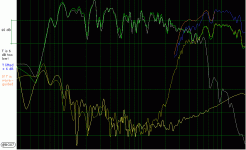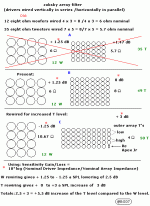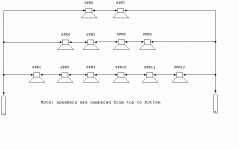Arrays installed, .. With the wide coverage of the arrays, I don't feel the need for a center channel AS MUCH as before. The horribly finished brown box is my auto-tuba horn sub, . soon to be replaced by something that goes deeper than its 30Hz or so. The efficient horn sub can keep up with the arrays powered by a measly 100W (my otherwise excellent ported shiva was hopeless at this, ...  )
)
The arrays are now spiked to improve their stability and floor-coupling.
 )
)The arrays are now spiked to improve their stability and floor-coupling.
An externally hosted image should be here but it was not working when we last tested it.
zobsky:
I think your T level is too low and as to start with always should be equal or higher before choosing crossover components.
It’s also second to none when it comes to the importance of having a good FR response to an even impedance curve.
See picture 1(2).
Obviously there is a need to increase the T level about + 6 dB. See one possibility in picture 2(2) where the T level is raised 5.5 dB.
b
1(2)
Here's the response with the crossover, pretty good, I'd say.
I think your T level is too low and as to start with always should be equal or higher before choosing crossover components.
It’s also second to none when it comes to the importance of having a good FR response to an even impedance curve.
See picture 1(2).
Obviously there is a need to increase the T level about + 6 dB. See one possibility in picture 2(2) where the T level is raised 5.5 dB.
b
1(2)
Attachments
Thanks for your many useful suggestions, bjorno .
I know. and agree with, what you are saying, ... In practice though, .. I haven't found the tweeter level to be too low to much of an issue, though I do sense it a bit. In fact, it helps a bit by making bright recordings more listenable. It also provides a built-in fletcher munson curve of sorts.
I don't want to re-wire a bunch of tweeters right now, and more importantly spend more money on the crossover.
But here's what I have been doing / plan to do
1. Use EQ in foobar 2000 to boost tweeter levels a bit and cut down the mid bass / mid range a bit.
2. I could instead re-wire the woofer array as a (2-4-6) power tapered array and still maintain close to the same impedance, with the added benefits of lowered sensitivity and potentially more accurate soundstaging.
3. The choice of cheap tweeter and tweeter - tweeter spacing (I can't go much closer as the flanges are litereally touching) is causing a roll off in the high treble (see graph above 13 KHz) . This isn't much of an issue, except that some recordings miss some "air" (cymbals etc .. ) . I've being playing with my set of radio shack supertweeters crossed over first order at about 12-14 KHz to provide some ambiance. The effect is subtle but the results are promising, though I haven't made the final decision.
I know. and agree with, what you are saying, ... In practice though, .. I haven't found the tweeter level to be too low to much of an issue, though I do sense it a bit. In fact, it helps a bit by making bright recordings more listenable. It also provides a built-in fletcher munson curve of sorts.
I don't want to re-wire a bunch of tweeters right now, and more importantly spend more money on the crossover.
But here's what I have been doing / plan to do
1. Use EQ in foobar 2000 to boost tweeter levels a bit and cut down the mid bass / mid range a bit.
2. I could instead re-wire the woofer array as a (2-4-6) power tapered array and still maintain close to the same impedance, with the added benefits of lowered sensitivity and potentially more accurate soundstaging.
3. The choice of cheap tweeter and tweeter - tweeter spacing (I can't go much closer as the flanges are litereally touching) is causing a roll off in the high treble (see graph above 13 KHz) . This isn't much of an issue, except that some recordings miss some "air" (cymbals etc .. ) . I've being playing with my set of radio shack supertweeters crossed over first order at about 12-14 KHz to provide some ambiance. The effect is subtle but the results are promising, though I haven't made the final decision.
Attachments
I added a pair of 8 ohm radioshack bullet/horn supertweeters to boost the drooping top end. They work well. I'm merely adding them in via a simple 1st order crossover using some 1.4uF film caps I have lying around. The arrays are high passed at 100Hz in these measurements.
An externally hosted image should be here but it was not working when we last tested it.
A couple of pics
1. Ghetto-rigged mic + preamp
I fit the panasonic electret capsule to the end of the sleeve of a ball-point pen
2. Array with supertweeter
1. Ghetto-rigged mic + preamp
An externally hosted image should be here but it was not working when we last tested it.
I fit the panasonic electret capsule to the end of the sleeve of a ball-point pen
Code:
10 uF
+ | |
+---------------------+--------| |--------------> to sound card
| | | |
| (positive lead) |
| +----------/\/\/\---------+
MIC 2.2 kohm |
| | +
| (ground lead) (-) -------
| (battery 9v or so) ---
| |
| |
+-----------------------------------------------+----> ground2. Array with supertweeter
An externally hosted image should be here but it was not working when we last tested it.
Ah, .. a request for the audiophile blurb. Here goes.exipnos said:Congratulations on finishing up your arrays. So with the crossover finished, tweeters installed and the supertweeter going how do they sound. Could you give us some more info about that.
Cheers,
Exipnos
In short, they sound like a Velvet Hammer . Soft when they need to be, extremely dynamic when called upon, or when turned up. One of my test tracks for overall dynamic range and tonality is Dire Straits' "Private Investigations" . This track gets downright scary from the second half onwards played at an "appropriate" level. I can turn the volume up to way above my normal listening levels and there is no hint of strain or compression. Of late, I've been feeling like the "Maxwell Man" in my current avatar.
They don't have the most detail of any speaker I've heard (probably because of the cheap drivers I've used) but the info is all there from 70 - 80 Hz or so upwards. In practice, I cross over at 100 Hz to a sub (because that's the lowest setting on my receiver). More importantly, they are musical and, when used with a suitably efficient subwoofer, don't have a preference for any particular genre of music. Pop, Rock, Jazz, Electronica , Dub Reggae, Rap, Metal etc , .. none sound offensive on this speaker.
As you can see from my latest response curves, there is a slight dip between 2KHz and 5KHz. This is because the woofers are dropping off due to comb filtering and the tweeters haven't come in yet (my crossover is 5KHz 3rd order Butterworth with a zobel on the woofer line). . In practice, this works well as a sort of "BBC dip" effect making the speaker easy to listen to. Another thing I should mention is that despite crossing over an octave or so above the comb filtering threshold for my 5.25" drivers, I don't find that comb filtering is significantly muddying up the response or imaging. I'm sure there is some impact, but not enough for me to notice. Likewise, crossing over at 5KHz might have some impact on the array directionality (as pointed out by Bjorno earlier on in this thread), but it IS NOT an issue in practice.
For various reasons, I've had to position these arrays closer to the corners than I like. This results in a bit of boomy bass. I've placed some foam reflectors at the corners to work as makeshift bass attenuators. These have helped a bit. Depending on what I'm playing, I sometimes (not always, mind you) eq down a bit (3-5 dB) between 100 - 200Hz on Foobar2000 . I suspect that splaying the wings by a few degrees during construction would also help this a bit. I'ver been listening to these speakers for 2 - 3 hours a day for the past week, so this is all minor nitpicking.
These arrays are open back so the sound is open and natural. I wonder if imaging might suffer a bit because of all the reflected energy from the rear wave that is reaching my ears . Not an issue, ..just something to investigate later on.
You asked about my opinion on the tweeters. I think they're okay for the price. Surprisingly, I had to install a lot of them to get the efficiency up to meet the woofers. I could re-wire the arrays to boost the tweeter SPL and/or cut the woofer SPL . Without the supertweeter, the sound was smooth and listenable, . .the kind of sound you could listen all day and not get tired one bit.
However, I've decided to use the supertweeter approach instead for the following reasons:
1. I had the supertweeters lying around (bought on this forum some months ago at around $30 for the pair). http://support.radioshack.com/support_audio/14243.htm . They allegedly extend to 40KHz, so I suppose I could use them annoy the neighborhood pets.
2. Easier to do, and easily reversible
3. Listening to the tweeter line alone, these line arrays lack a bit of "air" for me, .. partly because of the comb-filtering effect which occurs a bit over 10-12 KHz and partly (I suspect) due to their inherent sound. In any case, I still consider them important in this project as they allow me to cut out the woofer above 5KHz (the woofer line doesn't sound very good above that, despite it almost matching the tweeter effieciency on the graphs). I found foobar2000 + the dsp crossover plug-in an invaluable tool to evaluate, by ear, the sound of the driver lines in various frequency ranges.
4. Luckily, these supertweeters approximately match the nominal line efficiency, so I don't have to worry much about padding them down. On bright recordings, I just notch the treble down slightly foobar 2000 EQ.
I find the supertweeter an invaluable addition to this system, as far as providing "bite", "air" and "spatial cues". I crossed it in 1st order at around 14000KHz (some might prefer a bit higher, but it sounds good as is, so I'm not going to bother changing it for now).
As an alternative, one might consider using an array of, say, dayton dome tweeters, as an alternative to my tweeter+supertweeter solution, but that's still going to cost some $$$ . This solution allows you to use cheap tweeters and still hit the high notes while maintaining the line array sound, at least in a domestic setting. Additionally, if you already have a pair of efficient tweeters that you like, this is a good way to put them to use.
One thing that I found imperative for these U-baffle arrays was to line the sides. I used some polyfill batting sheets from walmart. One packet was enough for a pair of lines, though there's still space for more. Maybe I should shred all the junk mail we get and stuff them in the remaining space. Without the lining, there were a lot of spurious reflections fuzzying up the sound. Another thing that was beneficial was side to side braces using a few wooden dowels
Are these the best arrays in the world? No
Am I happy with them? More than.
Approximate Cost for a pair (excluding any shipping costs):
24 Foster Woofers @ $3 = $72
100 Apex Jr Tweeters @ $0.50 = $50
1 pair radio shack supertweeters - $30 used
1 sheet 3/4"Home Despot Plywood = $30
30 ft Cat 5 plenum - not sure, .. approx = $25
Crossover Parts / Binding Posts / Spikes = $60
1 bag Polyfill batting, approx = $10
3- 4 wooden dowels = a few dollars
The grand total is right around $300 or, not a bad deal considering what this monster is capable of.
Hope I haven't put you to sleep.
Current / Future experiments:
1. Further experiments with damping the lines.
2. Currently playing with room treatments utilizing a large number of foam wedges I've been given
3. Experiments with sealing the back of the line to effectively transmission line - load the rear.
In order to serve the dual purpose of extending frequency response down into the 20's and annoying the wife, I've built a failry substaintial table tuba horn sub this weekend loaded with a tiny MCM 8". I haven't finished it yet but here it is. Sorry for the poor pic but I was in a hurry this morning.
I plan to countour the response down a bit from 60-70Hz onwards but so far, it kicks major butt.
Also, if you look, you can see that I've replaced the radioshack supertweeters with a pair of fountek JP2.0 ribbon tweeters. The tweeters were imbalanced and I got (what I think) was a very good local deal on the founteks, so ..... . For the record, the horn supertweeters were more dynamic, but the ribbons are more natural sounding.
I plan to countour the response down a bit from 60-70Hz onwards but so far, it kicks major butt.
Also, if you look, you can see that I've replaced the radioshack supertweeters with a pair of fountek JP2.0 ribbon tweeters. The tweeters were imbalanced and I got (what I think) was a very good local deal on the founteks, so ..... . For the record, the horn supertweeters were more dynamic, but the ribbons are more natural sounding.
An externally hosted image should be here but it was not working when we last tested it.
Dear Fellas,
I want to built a CBT array.
I already has the mid-bass driver. They are 5" Sony drivers, with the following parameters:
Fs = 59,7 Hz
Vas = 5,99 l
Qts = 0,247
Qms = 3,46
Qes = 0,266 (EBP = 224)
Ls = 1,3 mH
Rds = 6,2 Ohm
Sd = 80cm2
Mms = 10,7g
Bxl = 9,7 Tm
16 pcs will be used per side, giving a 101dB sensitivity (without directivity) without horn loading, with a 1,2kHz upper corner frequency. (1 unit alone has a higher corner freuency of 4,5kHz9. When horn loaded they can give >106dB/W, but with a corner frequcny of 600 Hz.
I am searching for a suitable high frequency driver, and cameup with the ApexJR ribbon tweeter (isodynamic tweeter in real). They must have extremely low Mms, but i annot decide wheteher they lower cutoff freq of 5kHz is because
- Low ka, so lo series capacitor value at transformed air impedance (this coudl be easily solved with arraying, and horn loading)
- Transformed suspension compliance or the compliance of air in back cavity (the latter can be increased be an addition of a spacer)
If anybody has some info about their electrodynamic values: Bxl, Mms, Cms... I would be really happy, since with these values I could model the operation, and simulation operation in array of 50 pcs, and also with some horn loading.
I want to built a CBT array.
I already has the mid-bass driver. They are 5" Sony drivers, with the following parameters:
Fs = 59,7 Hz
Vas = 5,99 l
Qts = 0,247
Qms = 3,46
Qes = 0,266 (EBP = 224)
Ls = 1,3 mH
Rds = 6,2 Ohm
Sd = 80cm2
Mms = 10,7g
Bxl = 9,7 Tm
16 pcs will be used per side, giving a 101dB sensitivity (without directivity) without horn loading, with a 1,2kHz upper corner frequency. (1 unit alone has a higher corner freuency of 4,5kHz9. When horn loaded they can give >106dB/W, but with a corner frequcny of 600 Hz.
I am searching for a suitable high frequency driver, and cameup with the ApexJR ribbon tweeter (isodynamic tweeter in real). They must have extremely low Mms, but i annot decide wheteher they lower cutoff freq of 5kHz is because
- Low ka, so lo series capacitor value at transformed air impedance (this coudl be easily solved with arraying, and horn loading)
- Transformed suspension compliance or the compliance of air in back cavity (the latter can be increased be an addition of a spacer)
If anybody has some info about their electrodynamic values: Bxl, Mms, Cms... I would be really happy, since with these values I could model the operation, and simulation operation in array of 50 pcs, and also with some horn loading.
- Status
- This old topic is closed. If you want to reopen this topic, contact a moderator using the "Report Post" button.
- Home
- Loudspeakers
- Multi-Way
- My Line Array Project Log


